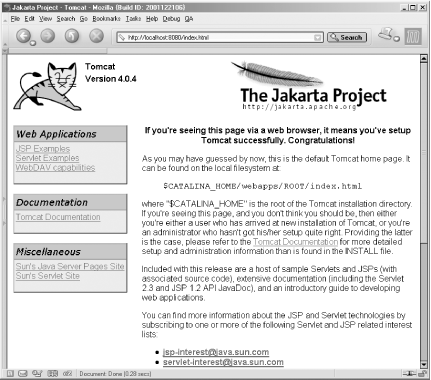The Tomcat installation
directory contains a number of
subdirectories. All of them are described
in the README.txt
file, but the most important ones are:
Two more subdirectories under the Tomcat home directory are created the first time you start the server:
To test the server, run the startup script as described in the platform-specific sections, and (assuming you’re running Tomcat on the same machine as the browser and that you’re using the default 8080 port for Tomcat) open a browser and enter this URL in the Location/Address field: http://localhost:8080/.
The Tomcat main page is shown in the browser, as in Figure 4-2, and you can now run all servlet and JSP examples bundled with Tomcat to ensure everything works.
If you’re trying this on a machine that sits behind
a proxy, for instance on a corporate network, and instead of
Tomcat’s main page you see an error message about
not being able to connect to localhost, you need
to adjust your proxy settings. For
Netscape 6 and
Mozilla, you find the proxy settings
under Edit → Preferences → Advanced
→ Proxies, and for Internet Explorer 5, you find them under
Tools → Internet Options →
Connections → LAN Settings. Make sure that the proxy
isn’t used for local addresses, such as
localhost and 127.0.0.1.
When you’re done testing Tomcat, you stop the server like this:
C:\Jakarta\jakarta-tomcat-4.0.4\bin> shutdownYou should always stop the server like this, as opposed to killing the Tomcat process with Ctrl-C. Otherwise the applications don’t get a chance to close down gracefully, and when you start to connect to external resources, such as a database, various problems may occur.
Get JavaServer Pages, Second Edition now with the O’Reilly learning platform.
O’Reilly members experience books, live events, courses curated by job role, and more from O’Reilly and nearly 200 top publishers.


